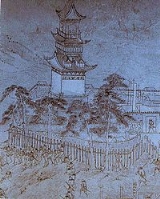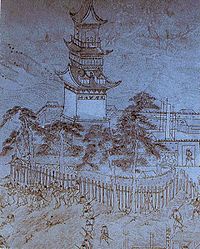
Suncheon Japanese Castle
Encyclopedia

Korean language
Korean is the official language of the country Korea, in both South and North. It is also one of the two official languages in the Yanbian Korean Autonomous Prefecture in People's Republic of China. There are about 78 million Korean speakers worldwide. In the 15th century, a national writing...
, Juntenjō (順天城) in Japanese
Japanese language
is a language spoken by over 130 million people in Japan and in Japanese emigrant communities. It is a member of the Japonic language family, which has a number of proposed relationships with other languages, none of which has gained wide acceptance among historical linguists .Japanese is an...
, is the only remaining Japanese castle in Jeollanam-do
Jeollanam-do
Jeollanam-do is a province in the southwest of South Korea. The province was formed in 1896 from the southern half of the former Jeolla province, remained a province of Korea until the country's division in 1945, then became part of South Korea...
, and the battle field of Yi Sun-sin
Yi Sun-sin
Yi Sun-shin was a Korean naval commander, famed for his victories against the Japanese navy during the Imjin war in the Joseon Dynasty, and is well-respected for his exemplary conduct on and off the battlefield not only by Koreans, but by Japanese Admirals as well...
who tempted Konishi Yukinaga
Konishi Yukinaga
Konishi Yukinaga was a Kirishitan daimyō under Toyotomi Hideyoshi. He was the son of a wealthy Sakai merchant, Konishi Ryūsa...
from here to Noryang Point known as Battle of Noryang Point
Battle of Noryang Point
The Battle of Noryang, the last major battle of the Japanese invasions of Korea , was fought between the Japanese navy and the combined fleets of the Joseon and Ming navies...
.
Characteristics
- Yagura (Guard Tower) : 3 at least.
- Moats, Gates and other structures.
- Date of Construction : December 2, 1597 (established).
- Founder : Ukita HideieUkita Hideiewas the daimyo of Bizen and Mimasaka provinces , and one of the council of Five Elders appointed by Toyotomi Hideyoshi. Son of Ukita Naoie, he married Gohime, a daughter of Maeda Toshiie...
, Tōdō TakatoraTodo Takatorawas a Japanese daimyo of the Azuchi-Momoyama period through Edo period. He rose from relatively humble origins as an ashigaru to become a daimyo...
. - Status : The 171st Jeollanamdo monument.
- Area : 188,428 ㎡.
- Location : Sinseong-ri, Haeryong-myeon, SuncheonSuncheonSuncheon or Sunchon is the name of two Korean cities:*Sunchon, North Korea*Suncheon, South Korea...
, Jeollanam-do.
History
The castle was built by the Japanese generals Ukita HideieUkita Hideie
was the daimyo of Bizen and Mimasaka provinces , and one of the council of Five Elders appointed by Toyotomi Hideyoshi. Son of Ukita Naoie, he married Gohime, a daughter of Maeda Toshiie...
and Tōdō Takatora
Todo Takatora
was a Japanese daimyo of the Azuchi-Momoyama period through Edo period. He rose from relatively humble origins as an ashigaru to become a daimyo...
as an outpost during the second invasion of Korea in 1597. The castle was constructed using mud and stone with scale of 120,600 ㎡, outside castle (Hangul
Hangul
Hangul,Pronounced or ; Korean: 한글 Hangeul/Han'gŭl or 조선글 Chosŏn'gŭl/Joseongeul the Korean alphabet, is the native alphabet of the Korean language. It is a separate script from Hanja, the logographic Chinese characters which are also sometimes used to write Korean...
: 외성) 2502m, inside castle (Hangul
Hangul
Hangul,Pronounced or ; Korean: 한글 Hangeul/Han'gŭl or 조선글 Chosŏn'gŭl/Joseongeul the Korean alphabet, is the native alphabet of the Korean language. It is a separate script from Hanja, the logographic Chinese characters which are also sometimes used to write Korean...
: 내성) 1342m. The site consists of 3 outside mud castles (Hangul
Hangul
Hangul,Pronounced or ; Korean: 한글 Hangeul/Han'gŭl or 조선글 Chosŏn'gŭl/Joseongeul the Korean alphabet, is the native alphabet of the Korean language. It is a separate script from Hanja, the logographic Chinese characters which are also sometimes used to write Korean...
:외곽성 or 토석성), 3 main stone castles (Hangul
Hangul
Hangul,Pronounced or ; Korean: 한글 Hangeul/Han'gŭl or 조선글 Chosŏn'gŭl/Joseongeul the Korean alphabet, is the native alphabet of the Korean language. It is a separate script from Hanja, the logographic Chinese characters which are also sometimes used to write Korean...
: 본성 석성) and 12 castle gates. It is the only castle preserved among 26 Japanese castles in the southern region.
The Japanese general Konishi Yukinaga
Konishi Yukinaga
Konishi Yukinaga was a Kirishitan daimyō under Toyotomi Hideyoshi. He was the son of a wealthy Sakai merchant, Konishi Ryūsa...
stayed in this castle with 14,000 troops to fight on two occasions with Joseon
Joseon Dynasty
Joseon , was a Korean state founded by Taejo Yi Seong-gye that lasted for approximately five centuries. It was founded in the aftermath of the overthrow of the Goryeo at what is today the city of Kaesong. Early on, Korea was retitled and the capital was relocated to modern-day Seoul...
and Ming
Ming Dynasty
The Ming Dynasty, also Empire of the Great Ming, was the ruling dynasty of China from 1368 to 1644, following the collapse of the Mongol-led Yuan Dynasty. The Ming, "one of the greatest eras of orderly government and social stability in human history", was the last dynasty in China ruled by ethnic...
(China) allied forces.
See also
- Siege of SuncheonSiege of SuncheonThe Siege of Suncheon was an unsuccessful Korean and Chinese Allied Forces attempt to capture Suncheon Japanese Castle late in the Japanese invasions of Korea .-Siege:...
- SuncheonSuncheon, South KoreaSuncheon is a city in Jeollanam-do, South Korea. Located in the province of Jeollanam-do,It is a scenic agricultural and industrial city of around 250,000 people near Suncheon Bay. It is located in the southeastern corner of Jeollanam-do, just over an hour south-east of Gwangju...
- WaeseongWaeseongJapanese castles in Korea are Japanese castles built along the southern shores of Korea during Japanese invasions of Korea between 1592 and 1598 by the Japanese militaries....
- Ulsan Japanese Castle
External links
- Map of Suncheon Japanese Castle
- Suncheon Waeseong (Castle built by Japanese), Chungmu Temple
- http://www.ngokim.pe.kr/imjin/~LWF0045.bmp
- http://www.ngokim.pe.kr/imjin/imjin.htm

